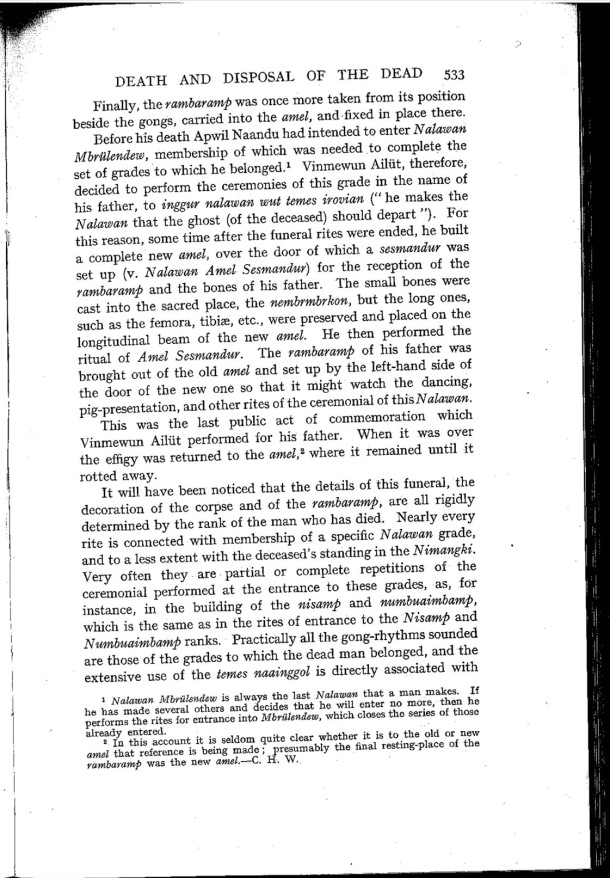|
|  [Note: this transcription was produced by an automatic OCR engine]
t
1
DEATH AND DISPOSAL or THE DEAD 533
Finally, the mmbammgb was once more taken from its position
beside the gongs, carried into the amel, andvï¬Åxed in place there,
Before his death Apwil Naandu had intended to enter N alawzm
M bnllendew, membership of which was needed to complete the
set of grades to which he belonged.‘ Vinmewun Ailiit, therefore,
decided to perform the ceremonies of this grade in the name of
his father, to inggur nalawam wwt temzs iroiï¬Åan (“ he makes the
Nalawmz that the ghost (of the deceased) should depart â€ù). For
this REASON, some time after the iuneral rites were ended, he built
a complete new amel, over the door of which a sesmamiur was
set up (v. N alawan Amel Sesmamiur) for the reception of the
rambammp and the bones of his father, The small bones were
cast into the sacred place, the nembrmbrktm, but the long ones,
such as the iemora, tibiae, etc., were preserved and placed on the
longitudinal beam of the new amel. He then performed the
ritual of Amel Sesmandur. The mmbmam4> of his father was
brought out oi the old amel and set up by the left-hand side oi
the door of the new one so that it might watch the dancing,
pig~presentation, and other rites of the ceremonial of thisNalamm.
This was the last public act of commemoration which
Vinmewun Ailiit performed for his father. When it was over
the efï¬Ågy was returned to the amel,’ where it remained until it
rotted away.
It will have been noticed that the details of this funeral, the
decoration of the corpse and of the mmbzwamgb, are all rigidly
determined by the rank of the man who has died. Nearly every
rite is connected with membership of a speciï¬Åc N alawan grade,
and to a less extent with the deceased’s standing in the N imangki.
Very often they are partial or complete repetitions of the
ceremonial performed at the entrance to these grades, as, for
instance, in the building of the nisamp and wumbuaimbamp,
which is the same as in the rites of entrance to the Nisamp and
N umbwaimbamp ranks. Practically all the gong-rhythms sounded
are those of the grades to which the dead man belonged, and the
extensive use of the temes naainggol is directly associated with
1 Nalaman Mbnilendsw is always the last Nalau/an that a man makes, If
he has made several others and decides that he will enter no more, then he
performs the rites for entrance into Mbvfllmdew, which closes the series of those
already entered.
i In this account it is seldom quite clear whether it is lo the old or new
amal that reierence is being made; presumably the ï¬Ånal resting»place of the
vumbammp was the new 1zmel.—C. H. W4
|